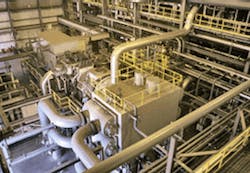Market Drivers for Cogeneration Are Changing
Washington DC, Wednesday, December 12 The market for cogeneration systems, also called combined heat and power or “CHP”, is changing. The constant drumbeat of news suggests that abundant natural gas supplies are expected to keep the price of the fuel at multi-year lows for the foreseeable future. As a result, the economics supporting CHP development are becoming increasingly attractive thereby driving more adopters to seek CHP for both its economic value proposition and for power reliability. Additionally, policy makers are beginning to better understand the air emission benefits and the vast quantities of water that can be saved in the power sector by deploying additional CHP thereby making water shortages in many areas of the country an important driver for additional CHP deployment.
Cogeneration is the production of electricity and the capture of the waste heat from the process and re-purposing that heat energy for heating, cooling or processing rather than dispensing it into the air or into a body of water like a typical power plant. By re-purposing wasted heat cogeneration systems can reach an efficiency of up to 80 percent which means that much less fuel needs to be consumed to produce the same amount of useful energy. Similarly, waste heat to power (WHP) systems capture waste heat from industrial processes and converts the heat to electricity and for use on site or for exporting for others to use. Currently, 82 gigawatts (GW) of installed CHP generation capacity (9 percent of U.S. energy-generation capacity) are in use at more than 4,100 sites across every state in the nation. But at least 50 GW, and up to almost 200 GW, of additional potential remain to be tapped. The potential for WHP projects is equally impressive, with more than 11,000 MW available at industrial sites as well as gas compressor stations, landfills and locations where gas flaring is occurring.
New policy initiatives at all levels of government, new equipment and technology advances, innovative project financing mechanisms and power price dynamics are all driving the decisions to install new CHP and WHP systems at manufacturing and chemical processing facilities where these systems can best supply their power and dispense the recycled heat energy. However, many other facilities ranging from hotels and hospitals to data centers and assisted living centers are also installing systems to efficiently heat and cool their facility while producing their own reliable and secure around-the-clock power.
Paul Cauduro, Director, World Alliance for Decentralized Energy’s Cogeneration Industries Council believes CHP and waste heat to power technologies will play an increasing role in the nation’s manufacturing renaissance. “Industrial demand for electricity is growing in every region and deployment of these economic, efficient and reliable on-site energy options will help satisfy this demand. In turn, more CHP system deployment will help the nation achieve important environmental and water saving goals.”
In April 2015, the World Alliance for Decentralized Energy (WADE) will bring together business and energy leaders, engineering consultants, project developers, policy specialists and system end-users to explore these new market drivers, discuss emerging technologies, examine policy changes and survey the growing demand for the energy security and resiliency offered by CHP and WHP systems in the industrial, commercial and institutional sectors. Information about the April 2015 event can be found at www.distribugen.org


